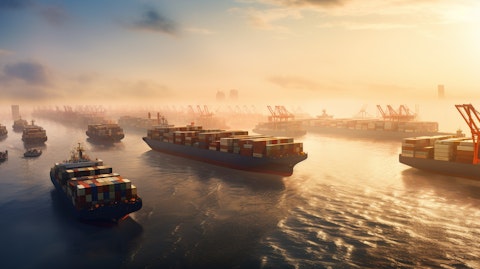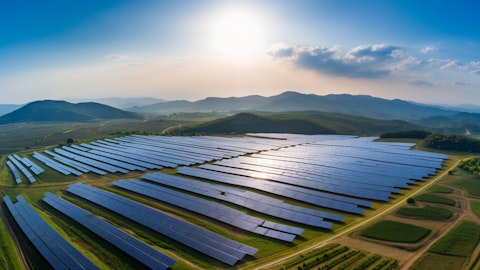SFL Corporation Ltd. (NYSE:SFL) Q3 2025 Earnings Call Transcript November 11, 2025
Espen Nilsen Gjøsund: Welcome to SFL’s Third Quarter 2025 Conference Call. My name is Espen Nilsen, and I’m Vice President of Investor Relations in SFL. Our CEO, Ole Hjertaker, will start the call with an overview of the third quarter highlights. Then our Chief Operating Officer, Trym Sjølie, will comment on vessel performance matters, followed by our CFO, Aksel Olesen, who will take us through the financials. The conference call will be concluded by opening up for questions, and I will explain the procedure to do so prior to the Q&A session. Before we begin our presentation, I would like to note that this conference call will contain forward-looking statements within the meaning of the U.S. Private Securities Litigation Reform Act of 1995.
Words such as expects, anticipates, intends, estimates or similar expressions are intended to identify these forward-looking statements. Please note that forward-looking statements are not guarantees of future performance. These statements are based on our current plans and expectations and are inherently subject to risks and uncertainties that could cause future activities and results of operations to be materially different from those set forth in the forward-looking statements. Important factors that could cause actual results to differ include, but are not limited to, conditions in the shipping, offshore and credit markets. You should, therefore, not place undue reliance on these forward-looking statements. Please refer to our filings within the Securities and Exchange Commission for a more detailed discussion of risks and uncertainties, which may have a direct bearing on operating results and our financial condition.

Then I will leave the word over to our CEO, Ole Hjertaker, with highlights for the third quarter.
Ole Hjertaker: Thank you, Espen. We are pleased to announce our 87th consecutive dividend as we continue to build SFL as a maritime infrastructure company with a diversified and high-quality fleet. For the third quarter, we reported revenues of $178 million and an EBITDA equivalent cash flow of $113 million. Over the past 12 months, EBITDA amounts to $473 million, reflecting the continued strength and stability of our operations. In recent quarters, we have taken decisive steps to strengthen our charter backlog, securing long-term agreements with strong counterparties and deploying high-quality assets. At the same time, we have made substantial investments in cargo handling and fuel efficiency upgrades across our fleet while divesting older and less efficient vessels.
Our Chief Operating Officer, Trym Sjølie, will elaborate on this later. As part of our fleet renewal strategy, 5 57,000 deadweight ton dry bulk vessels built between 2009 and 2012 have been sold with the final vessels delivered in the third quarter. In addition, 8 older Capesize bulkers were redelivered to Golden Ocean and 7 2002-built container ships were redelivered to MSC during the second and third quarters. These actions, combined with our efficiency upgrades have materially improved the operational and fuel efficiency profile of our fleet, delivering tangible benefits to both SFL and our customers. We have also advanced our commitment to cleaner technology with 11 vessels now capable of operating on LNG fuel, including 5 newbuildings currently under construction.
Q&A Session
Follow Sfl Corporation Ltd. (NYSE:SFL)
Follow Sfl Corporation Ltd. (NYSE:SFL)
Receive real-time insider trading and news alerts
During the third quarter, we announced new 5-year charters for 3 9,500 TEU container vessels on charter to Maersk, adding approximately $225 million to our charter backlog from 2026 onwards. These vessels will be upgraded with advanced cargo handling and fuel efficiency features in line with our larger containership fleet. Turning to the Offshore segment. The drilling rig Hercules remained idle also in the third quarter. While we continue to evaluate strategic alternatives for Hercules, we remain optimistic about securing new employment for the rig in due course. Hercules remains warm stacked and can be mobilized on relatively short notice. So it is difficult to provide timing guidance at this stage. With the announced $0.20 dividend, SFL has now returned approximately $2.9 billion to shareholders over 87 consecutive quarters.
This represents a dividend yield of over 10% based on yesterday’s share price. Our charter backlog stands at $4 billion with 2/3 contracted to investment-grade counterparties, providing strong cash flow visibility and resilience amid current market volatility. Over time, we have consistently demonstrated our ability to renew and diversify their asset base, supporting a sustainable long-term capacity for shareholder returns. Our solid liquidity position, including undrawn credit lines and unlevered vessels at quarter end ensures that we remain well positioned to continue investing in accretive growth opportunities. And with that, I will now hand the call over to our Chief Operating Officer, Trym Sjølie.
Trym Sjølie: Thank you, Ole. Our current fleet is made up of 59 maritime assets, including vessels, rigs and contracted newbuildings. Over the last 12 months, we have sold 22 of our older vessels at an average age of more than 18 years. This has reduced the fleet average by about 2 years to a new average age of less than 10 years per vessel. We have a diversified fleet of assets chartered out to first-class customers on mostly long-term charters and the majority of our customer base is large industrial end users. Our backlog from owned and managed shipping assets stands at approximately $4 billion, and the fleet following Q3 is made up of 2 dry bulk vessels, 30 container ships, 16 large tankers, 2 chemical tankers, 7 car carriers and 2 drilling rigs.
Our backlog is mainly derived from time charter contracts. And from Q3 onwards, we have 4 container ships left on bareboat leases, the rest on time charter. The charter revenue from our fleet was about $178 million, and we had a total of 4,748 operating days in the quarter. Operating days is defined as calendar day less technical off-hire and dry dockings or stacking for the rigs. Following several quarters with high number of ships in dry dock, this quarter, we had 2 vessels in dry dock at a cost of around $3.8 million. The 2 vessels in dry dock were 1 car carrier and 1 tanker. Our overall utilization across the shipping fleet in Q3 was about 98.7%. Adjusted for unscheduled technical off-hire only, the utilization of the shipping fleet was 99.9%, a very high availability.
In August, our car carrier SFL Composer had a collision in Denmark when approaching Golden [ Ocean ] pilot station going in for a special survey dry docking at Farahead. The collision happened when an overtaking container vessel struck the port quarter of the SFL Composer. There were no injuries to personnel nor pollution as a result of the incident. And furthermore, the vessel was empty of cargo in preparation for upcoming dry docking. She went straight into Farahead after the incident and completed her dry docking as well as damage repairs in a total of 34 days. We are fully covered for the extra time required for repairs by our loss of hire insurance as well as the damage repairs less USD 200,000 in deductible by our Hull & Machinery insurance.
It is likely we will recover part of the deductible following the outcome of court proceedings, alternatively a settlement with owners of the other vessel. The current commercial and regulatory environment means that energy efficiency and emissions reduction is fundamental to SFL’s ability to attract and retain first-class charters. Our toolbox includes energy efficiency measures, operational optimization and not least new low-emission fuel technology. We have taken significant strides in optimizing and renewing our fleet to meet these challenges by installing scrubbers, energy efficiency devices and investing in new tonnage with dual fuel capabilities. By modernizing and enhancing our fleet, we position ourselves for growth, either by providing new vessels with modern technology or extending the life of existing ones.
On the container side, we have, over the last 2 years, upgraded 13 container vessels with 3 more to come by carrying out major upgrades to cargo systems, energy saving technologies, propeller enhancements or replacements and Hull modifications like [indiscernible]. The upgrades amount to almost USD 100 million, fully or partly funded by our charterers and have been instrumental in securing new charters or charter extensions. On notable vessel acquisitions, we have since 2023, bought 2 dual-fuel chemical tankers and taken delivery of 4 LNG dual-fuel newbuilding car carriers. We also have 5 16,000 TEU dual-fuel LNG container vessels on order for charter to a leading European container operator. I will now give the word over to our CFO, Aksel Olesen, who will take us through the financial highlights of the quarter.
Aksel Olesen: Thank you, Tim. Starting with our financial performance. This slide illustrates how our diversified portfolio of vessels contributed to an adjusted EBITDA of $113 million for the quarter. Starting on the left, our container vessels remain the largest contributor at $82 million, supported by long-term charters with leading counterparties such as Maersk, Hapag-Lloyd and MSC. Our car carrier fleet added $23 million compared to $26 million in the second quarter as SFL Composer underwent a scheduled dry docking. The Tanker segment generated $44 million, benefiting from 17 vessels on long-term charters, further supported by strong underlying tanker market. Dry bulk contributed with $6 million, down from $19 million as over the last few quarters have divested certain dry bulk carriers as part of our overall fleet renewal strategy.
And finally, revenue from our energy assets of $24 million came mainly from the LINUS, which is on a long-term charter contract to ConocoPhillips until May 2029. Altogether, these operations produced $179 million in gross charter hire, including profit share income. After accounting for net operating expenses for about $66 million, we arrived at an adjusted EBITDA of $113 million, which highlights the strong underlying cash generation capacity of our diversified fleet of maritime assets. We then move on to our income statement. SFL delivered solid operational results in the third quarter, supported by stable charter hire income and disciplined cost control. Total operating revenue for the quarter was $178 million, including $1.8 million in profit share.
Vessel charter hire contributed with approximately $154 million, reflecting strong utilization across our shipping fleet, while the rigs contributed with approximately $26 million. Total operating expenses were $69 million compared to $86 million in the previous quarter, reflecting the recent divestments of vessels and fewer dry dockings during the quarter. After accounting for depreciation and financing costs, net income for the quarter was $8.6 million or $0.07 per share. Turning to our balance sheet. Our financial position remains strong and well capitalized. We ended the quarter with approximately $278 million in cash and cash equivalents, supplemented with approximately $40 million of undrawn credit lines, giving us total liquidity of approximately $320 million.
On the financing side, we made ordinary loan repayments of $56 million during the quarter. We have remaining capital expenditures of $850 million remaining on 5 container newbuildings expected to be funded through pre- and post-delivery financing, in addition to approximately $25 million on our existing fleet relating to efficiency and general upgrades. Looking at the capital structure, our book equity ratio stands at approximately 26% at the end of the third quarter. Let me close with a quick summary of SFL’s position today. We currently own and operate 59 maritime assets across key shipping sectors, including container, car carriers, tankers, dry bulk and offshore energy units. The diverse asset base gives us balanced exposure to multiple markets and long-term counterparties.
At quarter end, we have $278 million in cash and cash equivalents, reflecting a strong liquidity position and prudent financial management. Our fixed rate charter backlog now stands at approximately $4 billion, offering excellent visibility on future cash flows and earnings. These contracted revenues underpin both our dividend capacity and our ability to reinvest in modern fuel-efficient vessels. And finally, the Board has declared a quarterly dividend of $0.20 per share, marking our 87th consecutive quarterly dividend, a track record that very few companies in our industry can match. And with that, I give the word back to Espen, who will open the line for questions.
Espen Nilsen Gjøsund: Thank you, Axel. We will now open for a Q&A session. [Operator Instructions] We have our first question coming in through the chat. Do you guys expect Hercules to be leased in the new year? And the Gulf of America [ our ] Continental Shelf Oil and Gas Lease Sale 262, also referred to as lease sale BBG 1 under the Big Beautiful Bill Act is scheduled for December 10, 2025. Is that going to affect the Hercules lease potential?
Ole Hjertaker: Thank you. I think the best way to maybe explain that is that we are, of course, looking for all opportunities out there for the Hercules. However, referring specifically to the Gulf of Americas, this rig is a harsh environment, a specialized harsh environment drilling rig equipped to drill in winter season in the Northern Hemisphere. And the last campaign it was in Canada, where it was drilling partly during — going into the winter season. So there are a lot more rigs that can work in a more benign environment weather-wise like in the Gulf of Americas. And therefore, do not need the specifications and the features that the Hercules represents. So we have predominantly focused the marketing effort in the areas where this rig has unique capabilities and where there are relatively few rigs competing.
And that includes the North Sea and specifically the Norwegian Continental Shelf. It’s typically west of Shetland in the U.K. region. You have Canada, which also have very harsh environments. And you have certain areas in southern part of Africa like Namibia and potentially also South Africa. So we have focused the marketing effort there because there’s relatively less competition, and there are fewer rigs that can do that work.
Espen Nilsen Gjøsund: Thank you, Ole. We will take our next question from Sherif Elmaghrabi.
Sherif Elmaghrabi: Ole, just maybe to start off with a follow-up. It’s very helpful commentary around where the Hercules might work. But I’m interested also in the type of work, are you considering well intervention opportunities for the Hercules? Or do you feel that that’s something that might preclude you from drilling work?
Ole Hjertaker: No, we are looking for any opportunity to bring the rig out to work. So it could be well intervention or it could be exploration drilling. What we also did, and this is back in 2023 after we took the rig back, that rig had been working as an exploration rig for many, many years. And we did some upgrades to the rig to make it feasible also for development drilling where you have the potential for longer contracts. So we — our focus is to bring the rig back to work and produce positive cash flow. And exactly what work it’s going to do doing that, there we are more flexible.
Sherif Elmaghrabi: And then shifting to the tanker fleet. Most of your fleet is fixed past next year. But for those rolling off, given the sustained strength we’re seeing in tanker spot rates and the order book, of course, is it too soon to think about securing long-term work for these vessels?
Ole Hjertaker: Yes. It’s too soon. The vessels that run off first have 2-year options attached. So there is a possibility for the charterer to extend that charter. While saying that, there is also a profit share feature relating to those vessels, and these are 4 LR2 product tankers that have been on now almost 4 years on charter to Trafigura. And the profit share feature, and this is in case the vessels are being sold, these vessels would be significantly in the money. So it’s too early to have an opinion on what could — how that could — what that could transpire into. But we believe there is significant value beyond the book value embedded in those vessels linked to the profit share.
Espen Nilsen Gjøsund: We now have another question that we’ve gotten through the — we got through the system here. It’s from [ Harris Shannon]. Can SFL please provide any updates on the implementation of the $100 million buyback?
Aksel Olesen: Sure. Just to briefly comment on that. So we have about $80 million remaining on the buyback. And so far this year, we’ve bought back equivalent of $10 million of share at an average price of approximately $7.98 per share.
Espen Nilsen Gjøsund: We have another question from [ Climent Molins ].
Unknown Analyst: Today, we’ve seen some news on the office mentioning they may pause their attacks on commercial shipping in the Red Sea. If this truly holds, how fast do you think container ships operator will — how long do you think it will take for them to go back to the region?
Ole Hjertaker: Thank you. I think for now, it’s a little bit of a wait-and-see procedure. There have been periods in the past where the [ Hoodie] said that they were going to put sort of an ease to it and then suddenly, they started attacking vessels again. We are very — of course, always very concerned with the safety of the crew and the vessels. And while you can get insurance coverage for the — to take vessels through there, we are in close dialogue with our customers. And that is one good thing with working with, I would say, sort of blue-chip counterparties like work and others is that they are as concerned in doing this as we are. So I think there is a risk evaluation that will go on now. everybody noticed the sort of the statement.
But we also, as I said, seen that they changed their minds. So I think it’s going to be a relatively sort of slow, call it, rollback in activity through the Red Sea. I think for some of the countries around that, like Egypt, who have seen a massive decrease in canal fees, I mean, they certainly welcome it. So hopefully, we will see some more efficiencies in the fleet from that. From our perspective, in SFL, since we have our vessels on time charter, long-term time charter, we don’t make — this will not transpire into a higher time charter rate. But when — if and when our vessels move back into the Red Sea and you have shorter travel distances, we expect to see a reduction in operating expenses because one of the effects of the trading where many vessels that used to go through the Red Sea now go around Africa means that these vessels have had to run at higher speeds through the sea and therefore, have had higher engine loads and thereby been using more lubrication oil, for instance, and other factors than normal.
So that’s, I would say, more the direct effect on us if this actually materializes and if that trade goes back to normal.
Espen Nilsen Gjøsund: Okay. We have another one coming into the system from [indiscernible]. Do you have purchase obligations in any of your charter contracts? And if yes, can you share any details?
Aksel Olesen: Yes. In terms of purchase obligation, that’s something more in the past. I think the most recent ones are the 7 MSC vessels that were called or delivered back to MSC at, I believe, quarter end Q2. And then we have 4 more remaining in the associate that are on long-term bareboat to MSC. As we have mentioned on previous calls, we have kind of transformed the business from bareboats where you have various customers that have these purchase obligations to now run the ship on a time charter basis where we maintain and keep the upside in the residual value of the vessels. So predominantly, we own the residual. And in some instances, as Ole mentioned, we also have a profit sharing on those vessels where we take a significant part of the market upside as well.
Espen Nilsen Gjøsund: Another question from [indiscernible]. What is the outlook for new transactions outside of the Container segment?
Ole Hjertaker: Yes. we are segment agnostics. So we look at opportunities, I would say, across the maritime space. What we look for are opportunities where we can charter, I would say, more commodity type, not too specialized type vessels to very strong counterparties. So we’ve done deals in addition to the container segment, we’ve done car carrier deals with very strong counterparties. We’ve done tanker deals with very strong counterparties. We have relatively few dry bulk vessels left, but it’s definitely a segment we would like to do more business in. But it’s all down to structuring the right deals with the right return characteristics that fits our sort of threshold. So we are constantly looking for opportunities. We’re using our network to explore what we can do, but we cannot give specific guidance on how much we will invest in any specific segment.
We will announce deals if and when they materialize. And what we’ve seen in the past is that we don’t have a stable investment sort of per quarter type investment profile. We try — some quarters, there are fewer investments and then some quarters, there are no investments. And then in other quarters, there are higher investments. So I think this is balancing well out over time, but we definitely have investment capacity for new transactions currently.
Espen Nilsen Gjøsund: As there are no further questions from the audience, we would like to thank everyone for participating in this conference call. If you have any follow-up questions to the management, there are contact details in the press release or you can get in touch with us through the contact pages on our web page, www.sflcorp.com. Thank you for joining.
Follow Sfl Corporation Ltd. (NYSE:SFL)
Follow Sfl Corporation Ltd. (NYSE:SFL)
Receive real-time insider trading and news alerts




